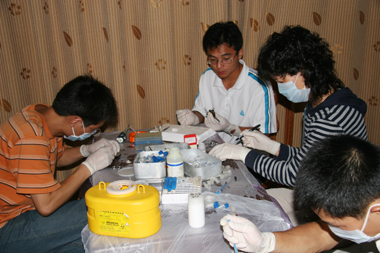The Wuhan Institute of Virology – believed by many to be a potential source for COVID-19 – wiped articles from its website detailing researchers getting “bitten” by wild bats.
The article – “Batwoman” team found the source of SARS virus” – was erased from the Wuhan lab’s website between May and August of 2020. The last available archive of the article, dated May 5th, 2020, details how a team led by the lab’s Center for Emerging Infectious Diseases Director Shi Zhengli collects bats for sampling.
While interacting with wild bats for SARS research – likely funded by U.S. taxpayers – a Wuhan Institue of Virology scientists revealed he was “bitten by a bat” in a now-deleted article from December 14th, 2017:
“Despite wearing gloves, the risk of being bitten by a bat still exists. Fan Yibi, a member of the research team, drew the length of a bat’s teeth. Not long ago, his index finger was bitten by a bat.
“Before sampling in the wild, we will inject rabies vaccine in advance. Among the viruses carried by bats, this is the most dangerous.” Fan Yi said.”
“Shi Zhengli, a researcher at the Wuhan Institute of Virology, Chinese Academy of Sciences, and Zhang Shuyi, a researcher at the Institute of Zoology, Chinese Academy of Sciences at the time, embarked on a journey to trace the source of the SARS coronavirus,” the China Youth Daily article prefaces its explanation of the Wuhan lab’s fieldwork protocols:
“As the research team leader, Shi Zhengli often leads teams to climb mountains and drill holes. Sampling work is usually a group of 4 people. The team members wear N95 masks, gloves, headlights, and coats, and set up bird nets at the entrance of the bat cave in the evening. At night, they took the bats in the falling net from the bird-catching net, and performed anal swab sampling overnight on a temporary workbench in the wild. They caught the bat, swabbed it with a cotton swab soaked in saline, and inserted it into the anus of the bat to take a sample.

After the anal swab is taken, the bat will be released. “Ms. Shi has always insisted on non-invasive sampling, try not to kill bats, and try to minimize the physical damage to bats when sampling.” Luo Dongsheng said. Some bat populations are very small, and destructive sampling is likely to cause a devastating blow to the entire population. Bats play an important role in maintaining the ecological balance. Hunting a large number of bats will cause significant losses to the ecosystem.”
The article also details how the Wuhan lab “isolated the first live virus of bat SARS-like coronavirus” that is “able to infect human cells”:
“In 2013, the laboratory of Wuhan Institute of Virology, Chinese Academy of Sciences, isolated the first live virus of bat SARS-like coronavirus from stool samples, and it was named WIV1 (WIV is the English abbreviation of Wuhan Institute of Virology). It is closer to SARS coronavirus than any bat SARS-like coronavirus previously discovered. It is the similar S gene that allows this bat SARS-like coronavirus to use the same receptor as SARS virus and be able to infect Human cells.”

